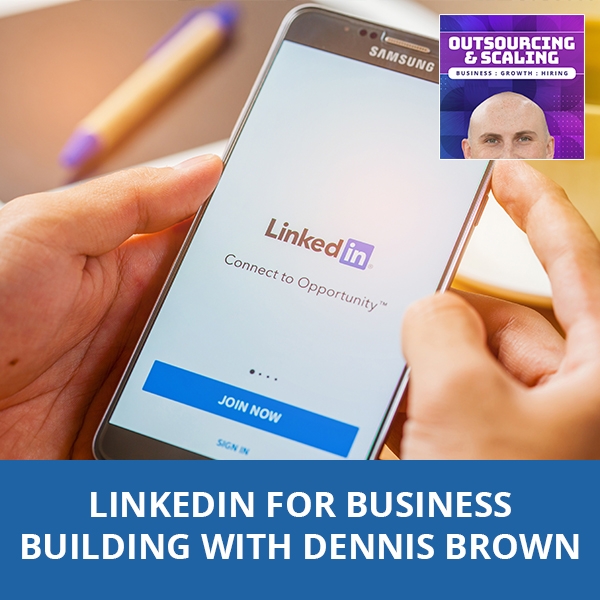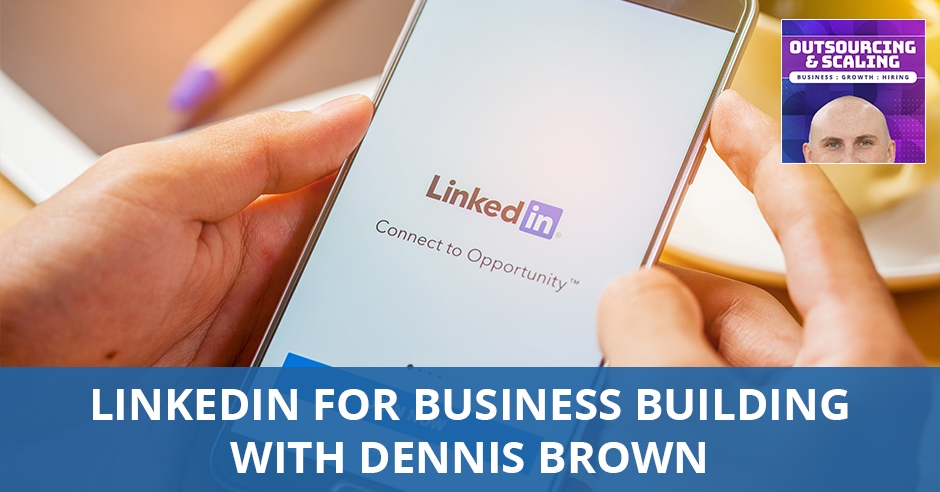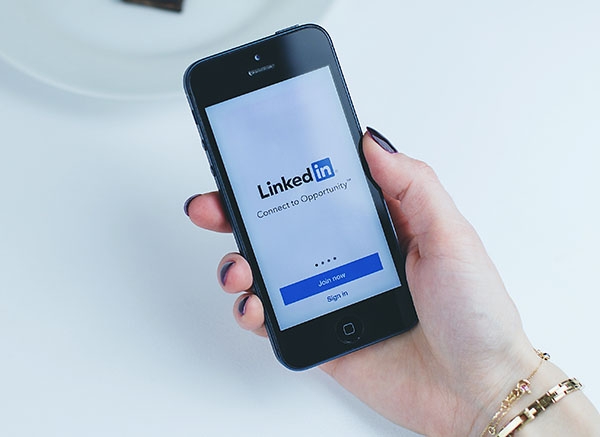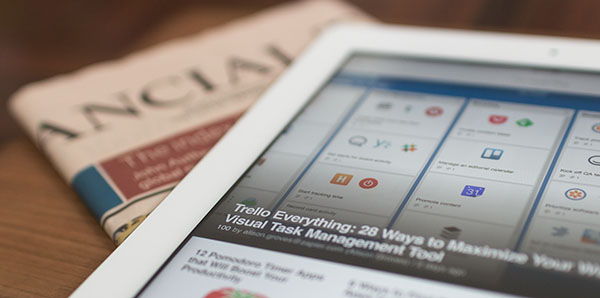


—
Listen to the podcast here:
[smart_track_player url=”https://www.podetize.com/statsapi/www.podetize.com/wp-content/uploads/fileuploads/11-5b145ef137b51b3d1af0633e9305c43d/07/2019/039f9ef8b8732652c95ef8802191970a.mp3″ title=”LinkedIn For Business Building with Dennis Brown” artist=”Nathan Hirsch” image=”https://freeup.net/wp-content/uploads/2019/04/OAS.png” ]
Download the audio file here.
LinkedIn For Business Building with Dennis Brown
I have a very special guest, Dennis Brown. Dennis, how are you doing?
I’m good. Thanks for having me.
Thanks for being here. For those of you that don’t know, Dennis Brown has built three multimillion–dollar businesses during his 25–year career as an entrepreneur. During that time, his companies have been ranked 7x on the prestigious Inc. 5,000 Fastest Growing company lists. He’s the author of The 7 Habits of Highly Successful LinkedIn Users and has generated over $20 million in new business from LinkedIn and social selling. He’s also the host of the top–rated podcast, Growth Experts, where he and his guest share proven growth strategies, tactics and tools. Dennis, thanks so much for being here. I want to talk about all of that. First, let’s take a gigantic step back to growing up. What kind of a kid were you? Were you a rebel or were you a straight–A student? Did you know you wanted to be an entrepreneur?
I didn’t know I wanted to be an entrepreneur. I had no clue what an entrepreneur was back then. Nobody in my family was an entrepreneur. I hadn’t been exposed to it. I never had those thoughts early on. I always had the side jobs and the side hustle mowing lawn and my grandfather had a farm. I’d worked with him on the farm and helped him but never had any aspirations of becoming an entrepreneur. I was a bit of an underachiever. I probably didn’t work as hard in school because it came a little easier for me. I played a lot of sports, wrestled all through high school and college and then it was after college that I got the entrepreneurial bug.
What college did you go to? What did you major in?
I went to the University of Buffalo, which is right in my backyard. I’m from Buffalo, Western New York area and my degree is in pre-law, but I decided not to continue on to law school when I got my first sales job. I started making a bunch of money and thought at that point that I could do it better than they did and started my first venture and failed miserably.
Engage with your engagers.
I’ve never had a corporate job and I feel like certain parts of having a corporate job or more real life, real world job experience helps you as an entrepreneur. Do you feel that way? Are there any skills that you learned while having a real job that maybe you wouldn’t have if you didn’t go through that experience?
The advice I give to young people who are curious and want to become an entrepreneur is I paint two pictures. The first picture is the equivalent of getting punched in the face for about five or ten years. That’s the reality. That’s what happened to me. It took me about almost ten years to get my footing. I tried a lot of things and I learned a lot of things, but I learned them through trial and error. I didn’t have a lot of mentors and I didn’t have a lot of structure. I was bouncing around with ideas. I’d make a little bit of money and I’d lose a little bit of money. I couldn’t get any rhythm.
I never hit that right project or maybe it was the right project, but it was the wrong time for me and I wasn’t ready to execute on it. That’s the one version I paint for young entrepreneurs. The other version is go learn some skills. Go learn some soft skills and some hard skills. Make yourself valuable and figure out what you want to do. Look at the market and see what people are doing. Look at the trends and see where you’re at. Get a good footing using Corporate America’s money for several years and get your footing under you. At that point, if you still think you want to be an entrepreneur, you can do it a little bit more strategically than I did.
I like that and I always wished that I had that experience. I don’t think I would’ve been happy working in a corporate job. You mentioned that you failed a lot at least early on. Talk to me about what those failures were and what you learned.
I graduated from college in 1992 and I got a sales job in March before I graduated in May. A few months before I graduated, I was the worst sales guy they had ever hired. I was horrible and I figured it out after about six months and then became the best sales guy in the office. Six months later, I thought that I figured it all out and I started my first venture. I tried a bunch of different things. Do you remember 900 numbers? They would market these different 900 numbers. I tried that and made a little bit of money doing it, but I didn’t like it. It was one of those things where you tried something. I also did a liquidation business where I would get liquidated goods from different manufacturers and distributors from past years’ models and then get them at a low price and resell them. That would be a great business now, but it wasn’t a great business then because there was no internet. This was back in the early ‘90s before the internet became popular. I tried to do some publishing.
There were different things I tried that I was interested in and I thought were compelling but after a couple of months of trying some of those things, I realized that it wasn’t working. I would pivot into something new. Finally, I started what’s called diverse funding and what we did is it was a niche funding business where we would buy owner–held mortgages. We brokered owner–held mortgages, structured settlements and lottery winnings. Anything that was in annuity where it was paid over time and people wanted cash up front, we would buy those. That business worked well. I was making six figures in that business but then got an opportunity to join a startup in the tech industry right in the late ‘90s. I closed that business because it wasn’t sellable because it was only me to pursue that. That was the first business that my partner and I ever took to seven figures.

Along that way, I’m assuming you hired a good amount of people.
Early on, there probably wasn’t a lot of hiring. I was the chief cook and bottle washer. I was doing it all but along the way, I started hiring some people that were helping with administrative, billing and even salespeople but a lot of this is pre–internet. My early days as an entrepreneur is the early internet.
Let’s talk about how your business mindset shifted from corporate to some early years and some failures and maybe being a little bit ahead of your time to where everything’s online. You’re using LinkedIn a ton and you’ve written a book. Talk to me about what your business is like and how you’ve structured it.
I’ve been an entrepreneur for several years and I’ve had some successful exits. I started at a B2B service company in 2003 and later sold that company in 2016 after growing it to about $80 million in sales. My business has changed dramatically. I’m not in the mindset to go work 80 or 100 hours a week like I used to. I’m not in the mindset to go out and grow a huge team or $100 million business like my previous goals. I’m much more focused on a lifestyle business. I have young kids, both girls. I like spending a lot of time with them and my family.
I work from home. My team is more virtual, which is a great part of the internet and the times we’re at. My business, I probably have five people on my team and they’re all virtual, 100%. A couple of them are in the states. The rest are abroad, whether that’d be in India, Pakistan and Philippines and then different project work that I’ll do depending upon what the project is. My business is predominantly I do LinkedIn coaching and consulting. I have a course that’s coming out. My LinkedIn marketing course is called Linked Academy.
Between the consulting, coaching and online courses, that’s predominantly what I’m doing now because it’s something that scales a little bit better for me. It’s something that I enjoy. I love doing internet marketing, content marketing and lead gen. LinkedIn happens to be one of those tools that I used to build my own business when I had a B2B service company, my logistics company. We used LinkedIn to generate over $20 million in new business for that B2B service company. I had no intentions of consulting or creating a course. I did it because I had to scratch my own niche. I needed a way to generate new clients and that became our go–to platform and we leveraged it well. It just so happened that when I pivoted out of there, LinkedIn and social media started to blow up. I accidentally fell into a consulting and coaching business that became very profitable.
If you ask and you ask in the right way, people will reply.
I want to talk about LinkedIn but first, talk to me a little bit more about managing a remote team. Communication, organizing them and motivating them, what have you learned and how do you do that effectively?
I learned that I sucked at it when I first started because I was used to managing everybody under one roof. It was a lot easier to do that. What I learned is that I didn’t have a framework for it. I learned through trial and error. What I know is this, in regard to hiring, it isn’t that difficult. There are a lot of platforms out there like you and the internet in general where you can find people that are looking for freelance work. There’s no shortage of people that want freelance work in almost any realm. I don’t care if it’s marketing, sales, administrative or whatever. You can find them and they’re out there but the most important thing that I’ve learned is the onboarding process.
This is where it all falls apart or it succeeds. Let’s speak to myself and maybe my small circle of friends where we’ve had this conversation. The first time they hire a VA or a freelancer, they bring them on and they start loading a bunch of work on them and then they check in on them maybe a week later or two weeks later. They expect all that work to be done and done perfectly. That is not going to happen. The onboarding process has to be very much like they’re a freelancer in your business working under your roof. If they were working next to you in your home office or in your corporate office, you need to treat it the same way. It needs to be very hands-on. It should be very hands-on for the first period of time until they get their legs under them. Don’t make the assumption that they know how to do everything perfectly and they know it exactly the way you want to do it.
Onboarding is the most critical step when you’re hiring a virtual team. What I do is I communicate with them through Zoom or Skype. We have regular communications, particularly during the early days. The other thing that I do is I take the time to create, if I have a job that they’re supposed to do, say it’s working on my blog and posting my podcast episodes, maybe they’re publishing my podcast episodes to Libsyn for the Growth Experts podcasts or maybe they’re publishing my podcast episodes to my website. I’ll create a video using one of the screen grab software and I’ll walk through the exact steps. Here’s step one, two, three and four. It’s visual, audio and everything’s there. I send that to them and I say, “Get back to me with questions.” If they don’t have any questions, I say, “Go ahead.” If they have questions, we move forward. I give them one task at a time. Once they get proficient at that, I’ll add another test. It’s taking baby steps and being more involved and not making assumptions that they’re going to be able to hit the ground running.
That was all great information from someone. A lot of people hear that from me. I talk about that all the time. It’s great hearing it from someone who’s built a bunch of businesses and has a team of VAs. Let’s talk about LinkedIn. You’re on LinkedIn. I’m on LinkedIn. I’ve gotten plenty of clients from there. I do okay. I’m sure it could be better. What should people know about LinkedIn and what should they be using LinkedIn for that they’re not doing?
First, what they need to know about LinkedIn is that don’t sleep on LinkedIn. It’s that other platform that isn’t talked about a lot. You hear a lot about Facebook, Instagram and Snapchat. You hear about these other platforms and a lot of people sleep on LinkedIn because it was always looked at as that recruiting and job site. It’s shifted. It’s a platform where not only can you hire, find talent and get a job, but it’s the number one platform for B2B marketing and sales. Unequivocally, for B2B, it’s the place to be. If you’re selling to a business, that’s where you need to be. It’s the Gold Rush era of LinkedIn. A lot has changed in the last couple of years since Microsoft purchased LinkedIn. I don’t know if they’re directly connected but I don’t care because timing is great. At one point, it was a lot harder to leverage LinkedIn because the content was not a predominant part of how you would be able to generate leads and sales.

There are three primary ways you can generate leads and sales with LinkedIn. You can do a targeted outreach type campaign, almost like a cold email type campaign but through LinkedIn which is outreach and nurturing with some very specific and strategic messaging to try to cultivate a conversation to generate that offline. That’s an outreach strategy. You’ve got the content strategy, which is using predominantly LinkedIn updates, which is little microblogs or images. LinkedIn has native video plus they’re launching live video. There’s a beta program for live video.
Creating content is the biggest way that I use to generate leads. The third way is to do advertising to LinkedIn ads. That’s paid and significantly more expensive than Facebook but when you look at the lifetime value of a typical B2B client versus the lifetime value of a client on Facebook, it’s very different. I don’t mind spending $100 on a lead or $1,000 or $5,000 to get a client if your lifetime value is $50,000 to several hundred thousand, you don’t mind that. The one that most people can tap into if they’re smart is using content and using LinkedIn marketing. Most people that are online are already creating some form of content, blogs, YouTube videos, podcasts or something. They’re creating some form of content and you can start leveraging that content on LinkedIn.
I’ll give you a perfect example. In 2018, I generated over 3,500 inbound leads. People that reached out to me through my content, asked a question and for help, 3,500 inbound leads with no advertising, a 100% organic. It costs me zero. All I did was publish and post content three to five days a week but it was very targeted and very relevant to those target markets. It got a lot of engagement and then engagement breeds engagement. All of a sudden, some posts will get several thousand views, some posts will get hundreds of thousands of views but ultimately 3,500 inbound leads. I had so many inbound leads, I couldn’t touch them all. I couldn’t even nurture them all but through that, it generated multiple six figures for a consulting business that I paid nothing for the ads. Everybody asked me, “Do you do paid ads at all?” “No, I don’t have time.” I don’t need paid ads because LinkedIn is so good.
I do get a good amount of leads through LinkedIn. I post content every day. Some of my content gets not a hundred thousand but thousands of views. Some of it doesn’t and it flops. Maybe it gets a hundred or whatever. What are the keys to that? Is it the hook? Is it the right hashtags? How do you maximize the amount of people that see your content? You want to make it specific to your niche but in my case, any business owner FreeeUp applies to. How will people figure out how to get more views and also make sure that the right people are viewing that content?
A couple of tips and I can give you a resource at the end of this. I created a guide called The Ultimate Guide to Generating Inbound Leads with LinkedIn. It’s a 22–page guide that I put together, a trial and error of a year and a half worth of my own testing on what worked and what didn’t work and the framework of how to do that. I don’t have time to go into that whole thing, but I’ll share a couple of things with you. Number one, if you want leads, what happens is if somebody sees your content, if they like your content, they’re going to go over to your profile and they’re going to scrub you a little bit. They’re going to qualify and say, “What’s this guy’s background? What’s his story? Is he legit?”
It’s the Gold Rush era for LinkedIn because if you start leveraging your content, you can get crazy love.
First thing you need to do and I hate to start here but you have to have a strong profile. You’ve got to make a good first impression with your profile. The content is what gets them there but it’s your profile, your experience, your background and how they feel about you after they see your profile that they’re going to determine whether there are going to start asking you questions or engage with you. You’ve got to optimize that profile. Don’t make it look like a resume. Make sure it looks more like a personal website, a bio or a resource for clients. That’s number one and you’ve got to do that. I know that’s very simple and everybody says that. You could have the greatest content but if your profile sucks, nobody’s going to ask you a question. Nobody’s going to engage with you.
Another one is stop automating your LinkedIn updates. What I mean by that is Hootsuite, Buffer and MeetEdgar and all these tools. They’re great tools. I’ve used them for different platforms and I used to use them for LinkedIn but I believe personally, that you’re penalized by LinkedIn and other platforms for posting using these automation tools. They don’t want you to necessarily automate your posts, they want you to be on the platform. One of their primary measurements is time on platform. They don’t track how many posts. They do but that’s a secondary focus. It’s time on platform. How much time are you spending on Facebook? How much of your time are you spending on Instagram and how much time are you spending on LinkedIn? If you’re not spending time there, then they don’t like that. Their goal is for you to spend more time. Stop automating your posts.
Another good one and this is one that a lot of people don’t do and I don’t know if you do or not, Nathan, but it would help a lot if you don’t. You start getting engagement with the post. You get some likes and some comments but then what happens is you don’t engage back with those people. I call it engaging with your engagers. Most people say, “Dennis, that doesn’t scale. I don’t have time to do that.” I’ve got news for you, sometimes it’s not always about scale. Sometimes in order to grow, you’ve got to do things that are unscalable. I make it a point to anytime I can, as much as I can to reply back, comment and respond to those people that are engaging with my posts. What I find is this, they don’t necessarily respond more in that post but they’re significantly more likely to respond to future posts because they got some engagement with me. Everybody’s replied to somebody’s posts or to somebody’s blog comment and never heard back. The likelihood is you’re never going to respond again. You’re never going to engage because you didn’t get any love back.
The other thing that I see a lot of people making mistakes is they don’t ask for engagement. In almost every one of my posts, I always say, “Reply below with this,” and I ask a question or I have some call to action. It’s not a buy and it’s not a sell, it’s, “Give me some feedback,” because if you don’t ask, you don’t get. If you ask and you ask in the right way where you’re not asking for them to enter their email address or do something crazy, people will reply. Those are a few things you can do to engage the content. Other than having good content. In any content marketing, the headline always matters. Spend time putting that headline together of what that content is because they’re going to make a first impression on your content based upon that headline. If you don’t make a good first impression, you don’t make it compelling, they probably won’t read it or watch it.
Those are a few things and start using video. Video is hot and LinkedIn loves video. They launched Native video and it’s been received extremely well and they’re launching live. You can’t get live yet because it’s still in beta but start using video. Like Facebook in the heyday, when they started launching video, when you could do video content and live content, they put all the algorithm and all the juice and all the love towards the video and that’s where all the virality was. You get very little engagement with Facebook. That’s why I call it the Gold Rush era for LinkedIn is that if you start leveraging that same content, you can get crazy love.

Dennis, this has been great. I learned a lot. Check out his book. How can people find out more about you and what are you excited about?
What I’m excited about is I’m launching my course Linked Academy. That’s going to be my LinkedIn marketing and social selling system. I’m excited about my podcast, Growth Experts. We got ranked in the Top 100 for Business Podcasts. It’s not easy. That means the content is hitting home. If anybody wants to reach out to me or connect with me, connect on LinkedIn. It’s Ask Dennis Brown or you can go to my website, AskDennisBrown.com.
Dennis, thanks so much for coming on and have a great rest of the day.
Thanks, Nathan.
Important Links:
- The 7 Habits of Highly Successful LinkedIn Users
- Growth Experts
- Linked Academy
- The Ultimate Guide to Generating Inbound Leads with LinkedIn
- Ask Dennis Brown – LinkedIn
- AskDennisBrown.com
About Dennis Brown

